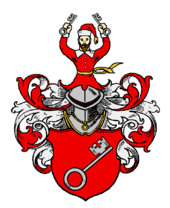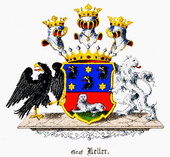Keller (noble family)
Keller is the name of an old family from Swabia ( letter nobility ). Members were in the service of the imperial city of Esslingen , the dukes of Württemberg and the dukes of Saxe-Gotha-Altenburg , the emperors of the Russian Empire , the kings of Prussia and the kings of Saxony . Its main seat since the 18th century was Stedten Castle near Erfurt .
history
In 1229, Olricus de Cella is mentioned, whom the family considers to be their ancestor. It follows in 1247 Heinricus de Cella , who appears as a knight in Ulm in 1247 . Albertus de Cella , possibly his son, was in the entourage of the Duke of Teck from 1268–1278 . Ulrich II, de Cella, mentioned 1268–1291, was again a councilor and judge in Eßlingen. Albrecht der Celler was a guild master and judge in Eßlingen in 1291 .
The GHdA-Adelslexikon describes that the further ancestry goes back to Heinrich den Kelner, winery owner near Eßlingen. The officially secure trunk series begins with Georg (Jörg) Keller, Mayor of Stuttgart.
Family tree (extract)
Heinrich der Kelner, urk. 1298–1329,
Weingutsbesitzer in Uhlbach bei Eßlingen,
Bürger und Richter in Stuttgart
|
Heintzlin Kelner, 1350 und 1357 Bürger von Stuttgart
|
Hainz Keller, † 1388 in Töffingen
|
Heins Kelner, 1393 erwähnt
|
Johannes Keller, gen. der Rotensteiner, 1420 Bürger von Stuttgart
|
Georg (Jörg) Keller, des Gerichts, 1451 Student,
1459, 1465, 1466, 1473, 1480 Bürgermeister von Stuttgart
|
Heinrich Keller, Richter in Stuttgart 1505–1509,
in Herrenberg 1517–1519,
in Lauffen 1520,
Untervogt in Dornstetten 1521,
Vogt in Hornberg 1523–1536, 1531 auch in Rosenfeld
|
Gregorius I. Keller, 1531 und 1533 Ratsherr, 1546 Bürgermeister in Stuttgart, † 1556
|
Christoph Keller, Verwalter in Walheim vorn 1584
|
Johann Hippolyt Keller I., um 1600
|
Johann Phillip Keller (?-1635), herzoglich-württembergischer
Kanzleiverwalter, Rentkammerrat zu Stuttgart
⚭ Beatrix Aulber (1598–1663), 4 Kinder
|
Johann Heinrich Keller (1622–1693), Reisiger Schultheiß und Amtmann
in Horrheim, Vogt in Lauffen
⚭ Anna Margareta Kallhardt, 7 Kinder
|
Friedrich Heinrich Keller (1653–1738),
1691 Obervogt in Tübingen und
Kommandant von Hohen Tübingen, herzoglicher Kriegsrat
⚭ (1.) Maria Magdalena von Gemmingen
⚭ (2.) Maria Magdalena Zeller (1666–1729), 13 Kinder,
|
Christoph Dietrich von Keller (1699–1788),
herzoglich württemberg. Geheimer Sekretär und Regierungsrat,
Kaiserlicher Reichshofrat, später in sachsen-gothaischen Diensten,
erwarb 1735 das Gut Stedten bei Erfurt und baute Schloss Stedten,
1737 geadelt
⚭ Auguste Louise Eleonore Freiin von Mauchenheim genannt Bechtolsheim (1732–1781), aus Tübingen,
________|_________________________________________
| |
Graf Christoph von Keller (1757–1827) Julie von Keller,
kgl. preuß. wirkl. Geheimer Rat, Staatsminister ⚭ 1774 den Bruder ihrer Mutter,
und Gesandter; Johann Ludwig Freiherr von Mauchenheim gen. Bechtolsheim,
am 29. November 1789 in den preußischen Grafenstand Vizekanzler von Sachsen-Weimar-Eisenach
erhoben, 11 Kinder
⚭ 1790 Amalie Luise Gräfin zu
Sayn-Wittgenstein-Berleburg (1771–1853),
eine Schwester des russischen Generalfeldmarschalls
Fürst Wittgenstein;
_______________|____________________________________________________
| |
Graf Gustav von Keller (1805–1897) Graf Theodor Ludwig Wilhelm
Landrat im Kreis Merseburg, auch königlich preuß. Kammerherr, von Keller (1791–1860),
Vorsitzender der Direktion der Thüringer Eisenbahngesellschaft Begründer der russischen Linie,
⚭ (1.) Mathilde von Bassewitz (1813–1847), 4 Kinder; Oberst der Garde
⚭ (2.) Mathilde Charlotte von Grolman (1813–1900) ⚭ Gräfin Sophie Eleonore Marie
| von der Borch-Lubeschitz,
Gräfin Mathilde von Keller (1853–1945) eine reiche Erbin, die ihm
Palastdame der Deutschen Kaiserin Auguste Victoria Großgrundbesitz im Gouvernement
Witebsk und Minsk mitbrachte.
Sie war eine Tochter des Grafen
Michael Johann von der Borch
Status surveys

- June 3, 1595 Imperial letter of arms in Esslingen for Alexander III. Keller (1538–1609), member of the council and court, mayor and mayor of Esslingen , through the Count of the Palatinate, Samson Hertzog.
- September 14, 1737 in Vienna Elevation of the ducal Württemberg Privy Councilor Christoph Dietrich Keller to the knightly imperial nobility with an increase in the coat of arms by Emperor Charles VI.
- September 30, 1738 in Vienna Old imperial nobility for the same and his brother, the ducal Württemberg Privy Councilor Johann David Keller.
- November 29, 1789 in Berlin, elevation of Christoph von Keller to the Prussian count .
- November 14, 1844 Russian count confirmation for his son, Count Theodor von Keller, on Ruskulowo in the Vitebsk governorate, imperial Russian colonel.
- June 28, 1905 Enrollment in the Estonian Knighthood for the siblings Count Paul, Comtesse Elisabeth and Count Alexander, the latter the landowner of Wennefer in Estonia.
- January 31, 1909 Entry in the Royal Saxon Nobility Book under No. 313 for the Royal Saxon Medical Councilor Dr. med. Alexander von Keller.
coat of arms
The 1595 the Esslingen council and court relatives Alexander III. The coat of arms awarded to Keller shows a red shield with an iron-colored key turned upwards at an angle to the left , the beard swept over itself. On the stech helmet with red and silver blankets a growing man in red, holding up a key in each hand, on his head a silver-topped red heather hat with a gold tassel.
The family coat of arms , as it was already used in his seal before 1667 by Johann Heinrich Keller (1622–1693), duchy of Württemberg bailiff of Gochsheim 1667, Vogt of Laufen 1668 ff. , Shows three (2: 1) eagle heads . One of the eagle heads growing on the crowned sting helmet. Portraits of Johann Heinrich and his brother Matthäus have survived, an oil painting of the former; by Mathäus Keller an engraving by Jacob von Sandrart after a lost painting by Rudolf Werenfels . Matthäus Keller in Nuremberg, born in Siebmacher's coat of arms, was born. 1620, probably identical to Matthew (d. 1661). He had three (2: 1) griffin heads (eagle heads with ears) in the coat of arms , a griffin head growing on the helmet. Incidentally, on the copper engraving mentioned, the coat of arms is drawn with eagles' heads (i.e. without ears). He was the stepfather of the pharmacist and philosopher Johann Leonhard Stöberlein (1636–1696), who after Matthäus Keller's death in Nuremberg continued his pharmacy to the golden jug under the haters .
John Henry's son, the lieutenant-colonel and commander of Hohentübingen Friedrich Heinrich Keller (1653-1738), had, most recently as Obervogt and bailiff to Merklingen , the parent coat of arms in its seal multiplied out, namely, by the free spaces between the eagle heads with three ( 1: 2) stars were filled. In addition, his coat of arms was crowned with a count's crown with nine visible pearls; To which his grandson Christoph von Keller (1757-1827) was authorized under nobility law after his elevation to the Prussian count status in 1789 .
The noble coat of arms (since the grandchildren of Johann Heinrich (1622–1693)) then shows, since 1737 (already increased again), a shield divided blue over red, with three (2: 1) black, gold-armored eagle heads on top, accompanied by three (1: 2) gold stars, and below a resting, looking silver lion on a green lawn. Shield holders of the count's coat of arms (since 1789) are a black eagle and a silver lion.
Web links
literature
- Eberhard Emil von Georgii-Georgenau : Biographical-genealogical sheets from and about Swabia , Stuttgart 1879, pp. 436–444
- Carola L. Gottzmann , Petra Hörne : Lexicon of German-Language Literature from the Baltic States and St. Petersburg , Verlag De Gruyter, Berlin / New York 2007, p. 264 (Count Michael Johann von der Borch)
- Gothaisches genealogical pocket book of baronial houses , Verlag Justus Perthes, Gotha 1855, p. 295ff ; 1862, p. 411
- Genealogical paperback of the count's houses, 1905, p.426ff
Individual evidence
- ↑ a b c d GHdA , Adelslexikon Volume VI, Limburg ad Lahn 1987, pp. 166–167
- ^ Sayn-Wittgenstein-Berleburg, Christian Ludwig Casimir Graf zu. Hessian biography. (As of March 12, 2013). In: Landesgeschichtliches Informationssystem Hessen (LAGIS).
- ↑ Lorenz M. Rheude , Wellers Archive for Stamm- und Wappenkunde , organ of the genealogical association Roland , 3rd year 1903, p. 116
- ↑ Merkelstiftung: Alexander III Keller
- ↑ Hjemstavnsbok Esslingen Family History: Alexander KELLER . This coat of arms also carried his great-great-grandson, the Esslingen guild master Alexander VI. Keller (1679–1746) (Merkel Foundation: guild master Alexander VI Keller ).
- ↑ Eberhard Emil von Georgii-Georgenau, Stuttgart 1879, Biographical-genealogical sheets from and about Swabia , p. 442
- ↑ Merkelstiftung: Illustration of the seal of Johann Heinrich Keller (1622–1693) , cellar book by Major General G. Keller (1922), p. 200: There are pictures of Johann Heinrich and Matthäus, of the former an oil painting in the possession of the seminar director Dr. Häcker in Heilbronn, a descendant of Johann Christoph C XVIII 7; by Mathäus an engraving by J. Sandrart after a lost painting by R. Werenfels in the possession of AW Alex. v. Cellar in Dresden. Incidentally, the coat of arms with eagle heads (without ears) is drawn on this engraving (see cellar book, p. 148 ). Kellerbuch (1922), p. 79 : Matthäus Keller in Nuremberg, b. 1620, probably identical to Matthew (d. 1661). He had three griffin heads in the coat of arms, 2: 1 set, a griffin head growing on the helmet.
- ↑ Georg Andreas Will , continued by Christian Conrad Nopitsch , Nürnbergisches Gelehrten-Lexicon or description of all Nuremberg scholars beyderley sexes based on their lives, merits and writings , Volume 7, Altdorf bei Nürnberg 1806, p. 294
- ↑ Keller, page 80: CXVII3 Friedrich Heinrich Keller - Lieutenant-colonel and commander on Hohentübingen
- ↑ Cellar book: 145 The coat of arms (representation of the seal of the lieutenant colonel and commanders on Hohentübingen, Friedrich Heinrich Keller (1653–1738))


